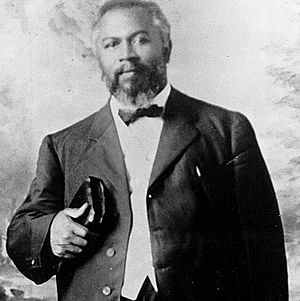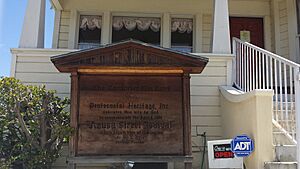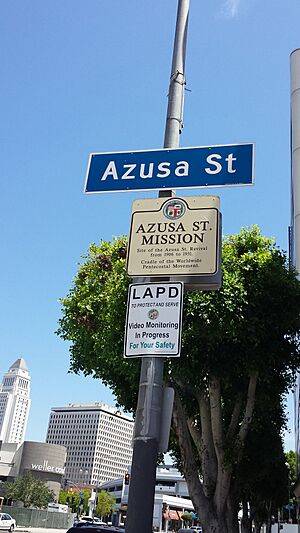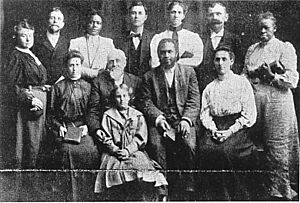Azusa Street Revival facts for kids
The Azusa Street Revival was a special series of revival meetings that happened in Los Angeles, California. It was led by William J. Seymour, an African-American preacher. This revival started on April 9, 1906, and continued until about 1915.
Seymour was invited to Los Angeles to preach for a month at a local church. But after his first Sunday, he was stopped from preaching there. This was because of his new ideas about baptism with the Holy Spirit. He kept teaching in the homes of people who supported him. On the night of April 9, 1906, something amazing happened. First one person, then six others in his meeting, began to speak in tongues and praise God loudly. The noise was so loud that people in the neighborhood noticed.
News spread quickly, and the city became excited. Large crowds gathered, so the services had to move outside. People came from all over. Some people felt a strong spiritual presence and fell down. Many said they were "baptized in the Holy Spirit" and that sick people were healed.
People who went to the Azusa Street Revival often said, "I am saved, sanctified, and filled with the Holy Ghost." This referred to three important spiritual steps for Holiness Pentecostals, who were the first group of Pentecostals. To fit the growing crowds, an old, worn-out, two-story building at 312 Azusa Street was found. This building was in an industrial part of the city. It had once been a church, but more recently it was used as a stable and storage place. In this simple Azusa Street mission, a continuous revival went on for three years. It became known all around the world. The revival was known for spiritual experiences, stories of physical healing miracles, worship, and speaking in tongues. Some news reporters and Christian theologians criticized the people for acting in ways that seemed unusual for that time.
Today, many historians believe this revival was the main reason Pentecostalism spread so much in the 20th century.
What Led to the Revival?
Starting in Los Angeles

In 1905, William J. Seymour was 34 years old. He was the son of former slaves. At that time, he was a student of a well-known Pentecostal preacher named Charles Parham. Seymour was also a temporary pastor for a small holiness church in Topeka, Kansas. From Parham, Seymour learned that being "baptized with the Holy Spirit" was a third important spiritual step. This step came after being born again and becoming fully sanctified.
Later in 1905, Neely Terry, an African American woman from Los Angeles, visited family in Houston. While there, she went to Seymour's church. He preached about receiving the Holy Spirit and speaking in tongues. Even though he had not yet experienced this himself, Terry was impressed by his message. When she returned to California, Terry suggested that Seymour be invited to speak at her local church. Seymour accepted the invitation in February 1906. He also received money and a blessing from Parham for his planned one-month visit.
Seymour arrived in Los Angeles on February 22, 1906. Within two days, he was preaching at Julia Hutchins' church. In his first sermon, he taught that speaking in tongues was the first clear sign of being filled with the Holy Spirit. The next Sunday, March 4, he found the church door locked. The church leaders did not agree with Seymour's teaching. This was mainly because he had not yet experienced what he was preaching about. The Holiness Church Association of Southern California also spoke out against his message. However, not everyone in Hutchins' church rejected Seymour's ideas. He was invited to stay at the home of Edward S. Lee, a church member. There, Seymour began to hold Bible studies and prayer meetings.
Meetings on North Bonnie Brae Street
Seymour and his small group of new followers soon moved their meetings to the home of Richard and Ruth Asberry. This house was at 216 North Bonnie Brae Street. White families from other local holiness churches also started to attend. The group met regularly and prayed to receive the baptism of the Holy Spirit.
On April 9, 1906, after five weeks of Seymour's preaching and prayer, something significant happened. They were also three days into a planned 10-day fast. Edward S. Lee spoke in tongues for the first time. At the next meeting, Seymour shared Lee's story. He then preached a sermon based on Acts 2:4 from the Bible. Soon, six other people also began to speak in tongues. This included Jennie Moore, who later became Seymour's wife. A few days later, on April 12, Seymour himself spoke in tongues for the first time after praying all night.
News of what was happening at North Bonnie Brae Street quickly spread. It reached African American, Latino, and white people in the city. For several nights, different speakers preached to curious crowds from the front porch of the Asberry home. People from all walks of life and different religious backgrounds came to listen. Even Julia Hutchins, who had locked Seymour out of her church, eventually spoke in tongues. Her whole congregation began to attend the meetings. Soon, the crowds grew very large. People were speaking in tongues, shouting, singing, and moaning. Eventually, the front porch of the house collapsed. This forced the group to look for a new place to meet.
The Azusa Street Mission
The Building and Its Conditions

The group from Bonnie Brae Street found an available building at 312 Azusa Street (34°02′54″N 118°14′28″W / 34.0483797°N 118.2411076°W) in downtown Los Angeles. This area was quite poor. The building had originally been an African Methodist Episcopal Church. The rent was $8.00 per month. A newspaper called the building a "tumble down shack." After the church moved out, the building had been used for many things. It was a wholesale house, a warehouse, a lumberyard, and even a stable. It was a small, rectangular building with a flat roof. It was about 60 feet (18 m) long and 40 feet (12 m) wide, making it 2,400 square feet (220 m2) in total. Its sides were covered with old, whitewashed wooden boards. The only sign that it had once been a church was a single Gothic-style window above the main entrance.
Inside, the ground floor was a large, barn-like room. It was messy with discarded wood and plaster. But it was cleaned up for services. They held their first meeting there on April 14, 1906. Church services were held on the first floor. Benches were arranged in a rectangle. Some benches were just planks placed on empty nail kegs. There was no raised stage, and the ceiling was only eight feet high. At first, there was no pulpit. Frank Bartleman, an early participant, remembered that "Brother Seymour generally sat behind two empty shoe boxes, one on top of the other. He usually kept his head inside the top one during the meeting, in prayer. There was no pride there.... In that old building, with its low rafters and bare floors..."
The second floor of the building, now called the Apostolic Faith Mission, had an office. It also had rooms for several people, including Seymour and his new wife, Jennie. There was also a large prayer room upstairs for overflow crowds from the services below. This prayer room had chairs and benches made from California Redwood planks.
By mid-May 1906, between 300 and 1,500 people tried to fit into the building. Since horses had recently lived there, flies were a constant problem for those attending. People from many different backgrounds came together to worship. There were men, women, children, Black, White, Asian, Native American people. There were also immigrants, rich, poor, illiterate, and educated people. People of all ages came to Los Angeles, some curious and some wanting to join. The mixing of races and the encouragement of women in leadership were very unusual. This was because 1906 was the height of the "Jim Crow" era, when racial segregation was common. Also, it was 14 years before women could vote in the United States.
Services and Worship Style
Worship at 312 Azusa Street was frequent and happened almost around the clock. Not only members of the Holiness Movement were attracted to the revival, but also Baptists, Mennonites, Quakers, and Presbyterians. One person who observed a service wrote:
No musical instruments are used. None are needed. No choir – the angels have been heard by some in the spirit. No collections are taken. No ads have been posted to announce the meetings. No church group is behind it. All who are close to God realize as soon as they enter the meetings that the Holy Ghost is the leader.
The Los Angeles Times newspaper was not as kind in its description:
Meetings are held in a run-down shack on Azusa Street. The followers of this strange teaching practice very wild rituals. They preach the wildest ideas and work themselves into a state of wild excitement in their unusual passion. Black people and a few white people make up the group. The neighborhood is made awful at night by the loud cries of the worshippers. They spend hours swaying back and forth in a tiring way of prayer. They claim to have the "gift of tongues" and can understand the babble.
The first edition of the Apostolic Faith publication described a common reaction from visitors to the revival:
Proud, well-dressed preachers came to "investigate." Soon their proud looks were replaced with wonder. Then they felt a strong conviction. Very often you would find them soon after, praying earnestly on the floor, asking God to forgive them and make them like little children.
Among the firsthand stories were reports of blind people getting their sight back. Diseases were said to be cured instantly. Immigrants speaking German, Yiddish, and Spanish were reportedly spoken to in their own languages by uneducated black members. These members translated the languages into English through a "supernatural ability."
Singing was not constant. It was done a cappella (without instruments), or sometimes there was singing in tongues. There were also periods of long silence. Attendees sometimes fell down in a spiritual experience. Visitors shared their stories, and members read aloud stories sent to the mission by mail. There was prayer for the gift of tongues. There was also prayer in tongues for the sick, for missionaries, and for any requests given by attendees or sent in. There was spontaneous preaching and altar calls for salvation, sanctification, and baptism of the Holy Spirit. Lawrence Catley, whose family attended the revival, said that in most services, Seymour would open a Bible. Then worshippers would come forward to preach or share their stories as they felt led by the Holy Spirit. Many people would continually shout during the meetings. The mission members never took an offering. However, there was a container near the door for anyone who wanted to support the revival. The main group of members at the Azusa Street Mission was never more than 50–60 people. But hundreds, if not thousands, of people visited or stayed temporarily over the years.
Charles Parham's Visit
By October 1906, Charles Parham was invited to speak at Azusa Street for a series of meetings. However, he was quickly uninvited.
When Parham arrived at Azusa Street, he was very upset by the mixing of races. He was shocked that black people were not in their "place." He simply could not stand "white people imitating unintelligent, crude negroisms of the Southland, and blaming it on the Holy Ghost." Parham walked through the crowd and stood at the pulpit. He then gave a strong criticism, saying, "God is sick at his stomach!" He went on to explain that God would not allow such "animalism." When it became clear that most of the Azusa Street Mission would not accept Parham's leadership, he left. He took about two to three hundred followers with him. He then started a rival campaign at a nearby Women's Christian Temperance Union building.
The Apostolic Faith Publication
Also starting in September 1906, the revival began publishing its own newsletter, called the Apostolic Faith. Issues were published sometimes until May 1908. This was mostly done by Seymour and a white woman named Clara Lum, who was a member of the Apostolic Faith Mission. The Apostolic Faith was given out for free. Thousands of ordinary people and ministers around the world received copies. Five thousand copies of the first edition were printed. By 1907, over 40,000 copies were printed.
The Apostolic Faith publication told the world about what was happening at the Azusa Street Mission. Its first issue's main story was titled "Pentecost has Come." It included a letter from Charles Parham, an article about Pentecost from the Acts of the Apostles in the Bible, and many short stories of people's experiences in the revival. One edition in 1907 wrote, "One sign of the Lord's coming is that He is bringing all races and nations together. They are filled with the power and glory of God. He is baptizing by one spirit into one body and preparing a people who will be ready to meet Him when He comes." The Apostolic Faith brought more and more attention to the events at Azusa Street and the new movement that was growing from the revival.
Lasting Impact
By 1913, the revival at Azusa Street had slowed down. Most of the media attention and crowds had left by 1915. Seymour stayed there with his wife, Jennie, for the rest of their lives. They were pastors of the small African American church. However, he often made short trips to help start other smaller revivals later in his life. After Seymour died of a heart attack on September 28, 1922, Jennie led the church until 1931. That year, the church lost the building.
Sending Missionaries Around the World
The Apostolic Faith newspaper and many regular news reports told the world about the Azusa Street Revival. Because of this, thousands of people visited the mission to see it for themselves. At the same time, thousands of people were leaving Azusa Street with the goal of sharing their faith abroad. Reverend K. E. M. Spooner visited the revival in 1909. He became one of the Pentecostal Holiness Church's most effective missionaries in Africa. He worked among the Tswana people in Botswana.
A. G. Garr and his wife were sent from Azusa Street as missionaries to Calcutta, India. There, they managed to start a small revival. Speaking in tongues in India did not allow them to speak the local language, Bengali. The Garrs later traveled to China. They arrived in Hong Kong and began to spread Pentecostalism in mainland China. They did this by working with other Protestant churches and groups that were already there. Garr greatly helped early Pentecostalism. He later changed the teaching about "biblical evidence." He shifted the belief that speaking in tongues was only for sharing the gospel. Instead, he taught that it was a gift for "spiritual strength."
Missionary Bernt Bernsten traveled from North China to investigate the events. He had heard that a Bible prophecy from Acts 2:4 was coming true. Other visitors left the revival to become missionaries in faraway places all over the world. So many missionaries went out from Azusa (about thirty-eight left in October 1906). Within two years, the movement had spread to over fifty nations. These included Britain, Scandinavia, Germany, Holland, Egypt, Syria, Palestine, South Africa, Hong Kong, China, Ceylon, and India. Christian leaders visited from all over the world.
The Start of the Pentecostal Movement
By the end of 1906, most leaders from Azusa Street had left to form other churches. Examples include the Apostolic Faith Church, the 51st Street Apostolic Faith Mission, the Spanish AFM, and the Italian Pentecostal Mission. These new missions were mostly made up of immigrant or ethnic groups. The Southeast United States was a very active area for the movement's growth. This was because Seymour's ideas gave a good explanation for a spiritually active atmosphere that was already growing there. Other new churches were started by preachers who had strong personalities and energy. Nearly all of these new churches were founded among immigrants and the poor.
Many existing Wesleyan-holiness groups adopted the Pentecostal message. Examples include the Church of God in Christ and the Pentecostal Holiness Church. These are now called Holiness Pentecostal groups. Holiness Pentecostals, like the Apostolic Faith Church, believe in three steps of grace: (1) New Birth, (2) entire sanctification, and (3) Baptism with the Holy Ghost. New church groups also formed. This happened because of differences in beliefs between Holiness Pentecostals and their Finished Work Pentecostal counterparts. Examples are the Assemblies of God formed in 1914 and the Pentecostal Church of God formed in 1919. These are Finished Work Pentecostal groups. An early disagreement about beliefs led to a split between Trinitarian and Oneness Pentecostals. The Oneness Pentecostals founded the Pentecostal Assemblies of the World in 1916 and the United Pentecostal Church in 1945.
Today, there are more than 500 million Pentecostal and charismatic believers around the world. In 1978, it was the fastest-growing form of Christianity. The Azusa Street Revival is widely seen as the beginning of the modern-day Pentecostal Movement.
|
See also
 In Spanish: Reavivamiento de la Calle Azusa para niños
In Spanish: Reavivamiento de la Calle Azusa para niños






